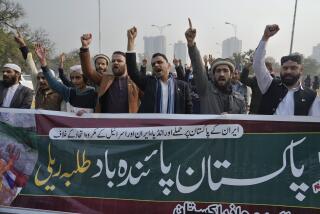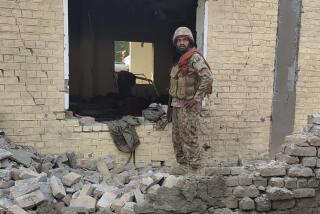Karachi siege exposes Pakistan military’s vulnerabilities
Reporting from Islamabad and Washington — The team of Islamist militants knew exactly where the naval base’s weak spot was.
Dressed in black and armed with AK-47 rifles, grenades and rocket launchers, they crept up to the back wall of Mehran Naval Station in Karachi, keeping clear of security cameras. Then, with just a pair of ladders, they clambered over the wall, cutting through barbed wire at the top, to launch a 17-hour siege that would renew disturbing questions about the Pakistani military’s ability to defend sensitive installations, including its nuclear arsenal.
The team, believed to consist of four to six militants, destroyed two U.S.-supplied maritime surveillance aircraft and engaged security forces in hours of pitched firefights. It was not until late Monday afternoon that Pakistani forces regained full control of the facility.
Interior Minister Rehman Malik said 10 Pakistani security personnel were killed and 15 were injured. Four militants died and two were believed to have escaped, he said.
The Pakistani Taliban, the country’s homegrown insurgency with ties to Al Qaeda, claimed responsibility for the attack, which it said was meant to avenge the May 2 killing of Osama bin Laden in the military city of Abbottabad.
The breach is likely to raise worries among leaders in the United States and Europe about the security of Pakistan’s approximately 100 nuclear weapons.
“I’m sure there will be concerns around the world about this, there’s no doubt about it,” said security analyst Talat Masood, a retired Pakistani general. “I think Pakistan will have to make certain that anything like this cannot be repeated from the standpoint of nuclear installations.”
Masood called the siege “a very strong indictment of Pakistan and its security forces and their ability to defend themselves. It will have a very demoralizing effect on the people, because if the security forces are unable to secure themselves and defend themselves, what expectations can the people have that the security forces will be able to defend the population?”
In Washington, retired Army Lt. Gen. David W. Barno said the attack “comes at a tough time for the Pakistani military. Not only was the U.S. able to infiltrate Pakistan and kill Osama bin Laden under their noses, now militants attack a Pakistani base. This has a shock value.”
Barno, who led the military command in Afghanistan from 2003 to 2005 and now is a senior fellow at the Washington-based Center for a New American Security, said the U.S. military is increasingly concerned that militant sympathizers appear to have infiltrated Pakistan’s military and intelligence services.
The siege at the naval base in Karachi, Pakistan’s largest city and its financial capital, began about 10:30 p.m. Sunday. Interior Minister Malik said the militants avoided the base’s heavily fortified front gate, instead approaching from behind, near the Shah Faisal Colony, a low-income neighborhood where Islamist militants have been arrested in the past.
They crossed a small stream behind the base, then used one of the ladders they had brought with them. Malik said the militants apparently knew about a gap in the coverage of two security cameras and chose that location to get inside. They placed the second ladder on the inside of the wall, climbed down, and darted toward the two large surveillance aircraft, kept in a hangar.
“They used very tactfully, intelligently, the place where there’s a gap where both cameras could not see,” Malik said.
Once on the tarmac, they blew up one of two P-3C Orion surveillance aircraft, given to the Pakistani navy by the U.S. in June. The explosion of the craft’s fuel tank destroyed the second surveillance plane nearby. The aircraft had special equipment for the detection of submarines and were used for maritime patrols.
Seventeen foreigners — six American and 11 Chinese workers — who were at the base when the siege began were unhurt. U.S. Embassy spokesman Alberto Rodriguez said the Americans were private contractors providing technical support for the surveillance aircraft. They were not connected with the embassy.
Of the 10 Pakistani security personnel killed, three were Navy commandos and one was a navy lieutenant who led a team of commandos to confront the militants once they had reached the surveillance aircraft, Malik said.
Three of the militants were shot to death by Pakistani security forces. The fourth went inside an office building at the base and detonated the explosives vest he was wearing. Malik said security forces were checking to see whether the militant had set any booby traps in the building.
Peter W. Galbraith, former deputy U.N. representative to Afghanistan, said the siege was not necessarily “indicative that the military is incompetent.”
“It is the dynamic of having lots of military locations and militants that can try to fight their way onto one of them,” said Galbraith, now a fellow at the Washington-based Center for Arms Control and Non-Proliferation.
In October 2009, militants stormed the army headquarters in the garrison city of Rawalpindi and took hostages, setting off a 22-hour standoff that ended in the deaths of 23 people, including nine militants.
For militants to infiltrate sites storing the nuclear arsenal would require a level of sophistication not yet seen by the groups, Galbraith said. “It is one thing to be able to get 18 people into a secure base and kill 12 security guards. It is another thing to try to grab a nuclear weapon and take it out. And then what would they do it? Some of these concerns are overwrought.”
At the same time, Galbraith said, there is a general concern about Pakistan, “a country building a lot of nuclear weapons. For what? That is troubling.”
Barno agreed that U.S. officials had “pretty high confidence” in the security of the Pakistani nuclear arsenal, having received repeated assurances that Pakistan maintains a complex system of safeguards, including storing the weapons unassembled and away from the launch apparatus.
The Pakistani Taliban had vowed to avenge Bin Laden’s killing with attacks on both Pakistanis and Americans. Their first major retaliatory strike came May 13, when twin suicide bombings killed at least 80 Pakistani paramilitary force recruits in the northwestern town of Shabqadar. On Friday, a car bombing targeted two U.S. Consulate vehicles in the northwestern city of Peshawar, killing a Pakistani bystander and slightly injuring the Americans.
Rodriguez reported from Islamabad and Bennett from Washington. Special correspondent Mansoor Khan in Karachi contributed to this report.
More to Read
Sign up for Essential California
The most important California stories and recommendations in your inbox every morning.
You may occasionally receive promotional content from the Los Angeles Times.











